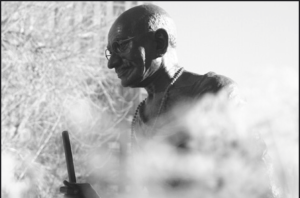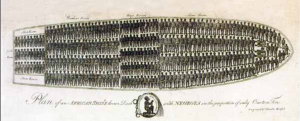Forms that symbolic politics can take
This page includes some ‘working notes’ on aspects of symbolic politics.
 Use of items from day-to-day life to make a large social issue immediate and close-to-home
Use of items from day-to-day life to make a large social issue immediate and close-to-home
The UK antislavery movement focused on boycotting sugar from the slave plantations, highlighting how reality “over there” (slave plantations) relates to reality “over here” (day-to-day use of sugar).
Symbolic politics involving a journey
• Greenpeace boat voyage to Amchitka
• Gandhi’s Salt March
• Dhammayietra in Cambodia: the “pilgrimage of truth” / “journey of Dhamma”
• Freedom Rides in USA and Australia
Popularising vivid imagery
UK antislavery movement use of image of slave ship and logo (Paul Townsend, Flickr)
Living as if the desired future already exists
Gandhi collecting salt, civil rights campaigners riding on buses, Aboriginal people creating their own embassy
Use of clothing
Gandhi’s cap and simple clothes, the uniform of the suffragettes.
Commemoration
US-based Veterans for Peace, a national organization of military veterans has been restoring the Golden Rule, the boat used in 1958 by pacifists to sail to the nuclear-bomb testing grounds in the Marshall Islands to protest nuclear proliferation. The boat was found derelict in a small California shipyard. They plan to sail it as both a symbol and a classroom for instruction against the manufacture and use of nuclear weapons.
See http://www.friendsjournal.org/the-golden-rule-shall-sail-again/ and http://harvardmagazine.com/2013/07/vita-albert-bigelow
The example set by the Golden Rule and her crew was also the inspiration for subsequent environmental and peace voyagers and craft that followed in her wake including the Phoenix of Hiroshima, and later Greenpeace and the Sea Shepherds
Breaking expected norms
Pope Francis travels by taxi rather than pope’s own vehicle, moves into simple apartments…
Political theatre/ “ethical spectacle”
• Woman’s epic Qld coastal walk highlights plight of Reef
http://mobile.abc.net.au/news/2013-08-16/womans-epic-qld-coastal-walk-highlights-plight-of-reef/4892078
• US Civil rights leader James Bevel: “Every nonviolent movement is a dialogue between two forces and you have to develop a drama, [you have] to dramatize the dialogue to reveal the contradictions in the guys you’re dialoguing with within the social context. That’s called a socio-drama.” (in Origins of the Civil Rights Movement Aldon D. Morris)
• Jeffrey Alexander on US civil rights movement: Southern white officials allowed themselves to become antagonists in a civil drama written and directed by the black protest movement. The melodrama presented Southern evil in an almost gothic way… Graphic reports of horrendous, lopsided physical confrontations between civil good and anti-civil evil were broadcast over television screens and splashed across front pages… in Performance and Counter-Power:The Civil Rights Movement and the Civil Sphere
• Nelson Mandela, facing charges in 1962 of inciting a riot and trying to leave the country without a passport, enters court dressed in traditional Xhosa leopard-skin clothing
Adaptation of popular culture
Greenpeace targets Volkswagen using Star Wars
http://www.youtube.com/watch?v=2pKCpZ6_HTY
http://www.greenpeace.org/international/en/news/Blogs/makingwaves/greenpeace-takes-on-vw/blog/44214
526,000 Greenpeace supporters worldwide successfully pressure VW to change its policy and its cars.
Use of anniversaries
On 27 May 1992, the twentieth-fifth anniversary of the 1967 referendum, Aboriginal activist Kevin Gilbert lit ‘international distress flares’ at the Aboriginal Embassy in Canberra to ‘signify to the world…the position Aboriginal People are in’.
_______________________________________________
Engagement of the public
Easy for others to replicate at local level and participate in response
- Gandhi’s cloth cap and spinning wheel
- Gandhi breaking the salt laws
- Antislavery movement boycott of sugar
All of these were widely-replicated by supporters of the campaigns in a way that a voyage by boat to a nuclear test site cannot
Creating meaningful events which define the meaning of social relationships and social phenomena
Symbolic politics points to /illustrates the meaning of a choice, and makes the choice clear – do you support this or that (destroying this rainforest or protecting it… etc)
_________________________________________
Relationship to social movement and broader public audiences
Symbolic actions designed primarily to energise activists
Golden Rule voyage against nuclear tests
Symbolic actions designed to engage new supporters / opponents / the broader public
Greenpeace voyage to Amchitka
_________________________________________
Demands on activists
Participation requires courage
Many instances from civil rights movement, monks’ protest in Burma…
Symbolic power sometimes derives from showing the lengths people will go to in order to pursue their values/ commitments.
_________________________________________
Conditions for symbolic action to be effectual
Reliance on alliance with government as well as challenging government to be effectual
U.S. Freedom Rides, Selma to Montgomery march
Economic boycott enhances effectiveness of symbolic politics
Lunch counter sit-ins in 1960s combined with boycott of stores
The decision to go to jail rather than accept bail:
to make the maintenance of segregation so expensive for the state… that they would hopefully come to the conclusion that they could no longer afford it….
James Farmer MSR 109
“remaining in jail, not only for its publicity value but for the financial pressure it would put upon the segregators.“
_________________________________________
Use of media
Symbolic politics creates a platform to speak to the public
Greenpeace can issue a scientific report for policymakers and express moral outrage for activists as a result of actions such as the voyage to Amchitka
Gaining international attention
Monks’ protest in Burma, 2007
Freedom Rides, USA, 1961, affecting Cold War politics and the image of the US abroad
Iconic images
Aboriginal Tent Embassy
Gandhi picks up salt on the Salt March
Nelson Mandela in gaol
“Free Nelson Mandela” becomes code for “end apartheid”
Soweto uprising
“Soweto Day” became a focus to rally the anti-apartheid movement and Soweto became iconic of what apartheid was.
Creating vivid images for viral videos
CAFOD creates video advocating for removal of European farm subsidies, by highlighting that EU governments spend enough money on the Common Agricultural Policy every year to fly all their 21 million dairy cows around the world.
http://news.bbc.co.uk/2/hi/technology/2282880.stm
Image of Gandhi: Paulo Fehlauer, Flickr
Image of slave ship: Paul Townsend, Flickr
